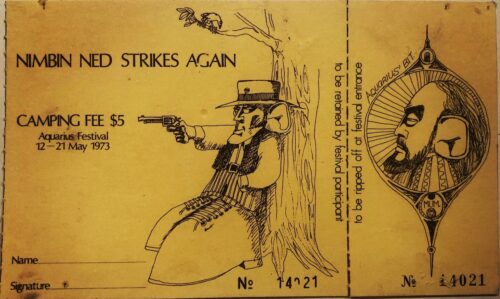This following extract is from the article “Creating Space for Protest and Possibility: Nimbin, Australia, from 1973” by Dr Rob Garbutt following the Aquarius and Beyond ‘Aquarius and Beyond: 40 Years On’ Conference in Nimbin, 23-24 May, 2013, a collaboration between Southern Cross University and Nimbin Aquarius Foundation Inc.
The genius of the 1973 Aquarius Festival was that it wove together space and time in Nimbin for collaborative, social experimentation and learning. This fostered an ethos among participants of taking action that was directed toward the possibilities of sustainable living in community… countercultural, nontraditional spaces for learning have been crucial in creating a culture of protest and resistance that has been sustained and developed since the early 1970s to the present day. The Aquarius Festival began this trend through the organising of a ten-day festival in which there was no set program for the participants apart from the promotion of a purposeful way of gathering together. Such spaces for learning provide time for developing knowledge for practical action that draws on skills, knowledge, energy, and materials at hand. Among the principles of such spaces are a commitment to resistance to such things as a culture of competition and the dominant extractive economy, and to ways of planning social space and developing technologies for sustainable, everyday living. This can be achieved in the space of an intentional community, a festival site, or a blockade camp… This is protest that is about enacting learning through collective participation in community as well as through raising a collective, public voice.
(This) history … is one of ongoing community resistance, protest, and learning. Following Isabelle Stengers, it is an approach to learning in the face of environmental concerns that is “constructivist, pragmatist and speculative” (Stengers, Isabelle. 2018. Another Science Is Possible: A Manifesto for a Slow Science. Cambridge: Polity. p.137). The approach is speculative in that it holds that, in response to a concern, another world is possible even if, and indeed because, the destination is unknown. It is constructivist because knowledge is constructed in collaboration with others, including nonhuman others such as a rainforest remnant, gathered around a common concern. And it is pragmatic in that learning proceeds through experience and experimentation in on-the-ground situations and in reflecting on what works. This type of learning has not happened without intent, and has been applied from one situation to another. This points to the importance of an ecology of learning practices though the argument here is not against sites of formal learning and knowledge production. In the ecology of learning practices, though, we need to value and create novel, nontraditional learning spaces of protest thinking-in-action in which time is allowed for creating sustainable, possible worlds in the ruins of late capitalism.
Garbutt, R. (2019). Creating Space for Protest and Possibility: Nimbin, Australia, from 1973. Contention, 7(1), 66-80. Retrieved Feb 19, 2025, from https://doi.org/10.3167/cont.2019.070106
